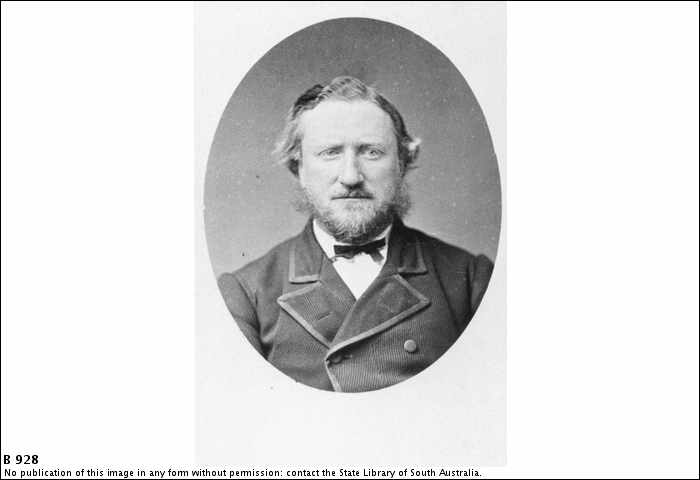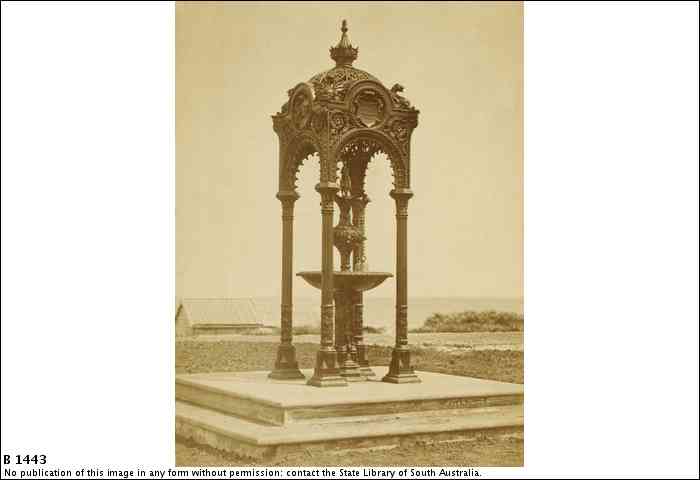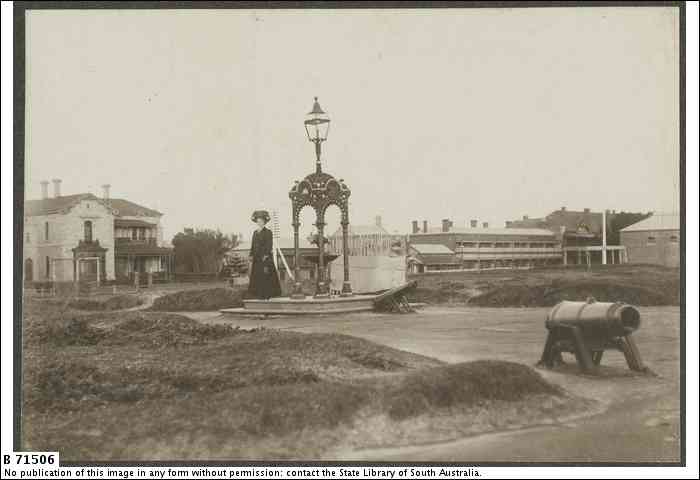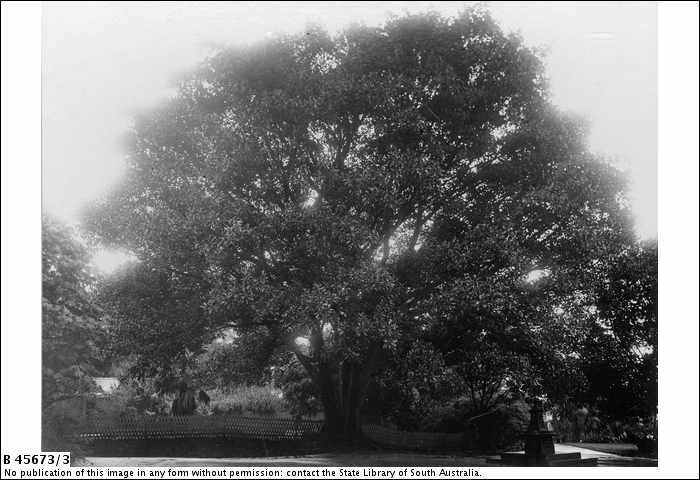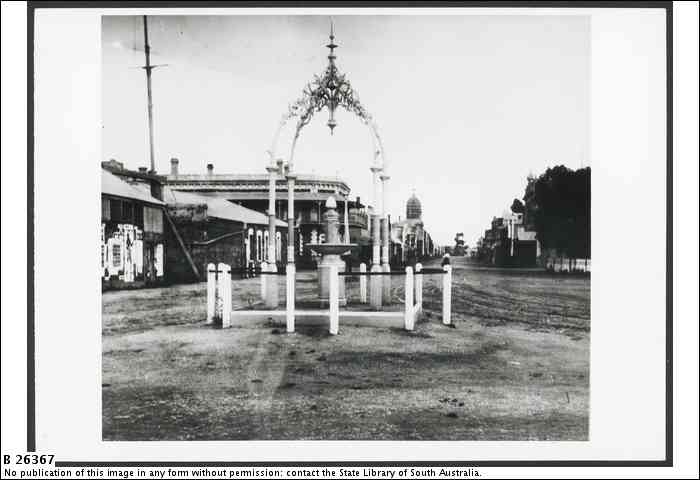Suggest a topic
Suggest a new Did you know? topic

Drinking fountains
891 ABC Afternoon Delights at the State Library : 11 July 2006
Carole Whitelock talked with Michael Talbot
Before piped water, Adelaide residents were dependent on carted water. Water carters filled up from 'a romantic spot on the river Torrens called the Ford, situated in a line from Morphett-street, and on a road running to North Adelaide. On the banks close by was the waterworks and baths of a private company, where the water was raised into elevated cisterns, and supplied to those watermen who preferred to pay the price of three pence a load to dipping it by means of a tin bucket and thus fill their casks from the river'. (Lewis, A handbook to the city of Adelaide, and a brief sketch of South Australia).
With this limited availability, there were unlikely to be many public drinking fountains.
A few drinking fountains predated piped water
Jacob Street, Gawler
James Mold, a Gawler baker, installed what the papers called 'the first water-fountain erected for the benefit of the public in this colony'. Murray Street is the main street in Gawler and James Mold had his shop in Jacob street that ran from there to Duffield & Turner's mill. There's a temperance element running through some of the early provision of drinking fountains and the paper said James Mold was a 'generous-hearted member of the Total Abstinence Society'. The fountain was in the garden, adjoining his shop. The paper doesn't say where the water came from, but it was for 'the gratuitous use of the public'. James Mold had roofed the area and intended installing seats to make it a convenient resting place. 'Many a passer-by, especially draymen, may be seen stopping and taking a refreshing draught' (South Australian Weekly Chronicle, 17 December 1859).
Commercial Road, Port Adelaide
Another drinking fountain to predated reticulated water was at Port Adelaide in 1861. Port Adelaide Corporation installed an ornamental octagonal iron column with a lamp in the middle of Commercial Road. A couple of pumps that looked like old fashioned bar-room beer pumps were mounted on the pillar and connected to a 400 gallon underground tank. Posts and chains round the structure gave space for people but prevented large animals drinking. Receptacles at the base of the column caught waste water for dogs. Fuller & Co. had the goods contract for the City and Port Railway. They agreed to cart water from Adelaide and keep the tank full, free, while they had the contract (SA Register, 2 September 1861).
Thorndon Park Reservoir
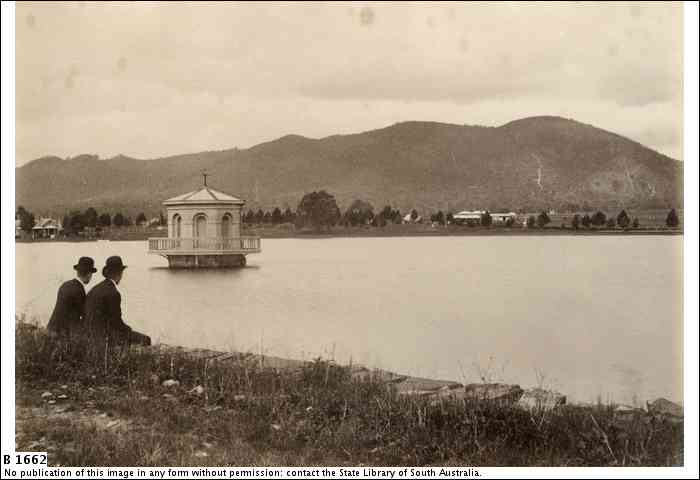 |
|
|
B 1662 - Thorndon Park Reservoir, c.1889 |
Thorndon Park reservoir was opened in 1860 and piped water was introduced to Adelaide households. Reticulated water was welcomed but some people felt it was happening too slowly. In March 1861 a South Terrace resident complained in a letter to the editor suggested political favouritism meant North Adelaide residents were being connected first. Installation should be speedy so residents wouldn't have to rely on 'liquid manure' bought from water carriers (SA Register, 7 March 1861).
Piped water brought calls for drinking fountains
A February 1859 newspaper article said 'The presence of very hot weather and the probability of our new waterworks being shortly in operation afford us an excellent opportunity of recommending for adoption in Adelaide the system of street fountains which has now become popular both in England and the adjoining colonies.'
Market towns in England all had their market pump. In England and Scotland private individuals had given drinking fountains. Railways and other heavily used places were likely to install fountains. Melbourne and Sydney had drinking facilities on some street corners.
The 'possibility of always getting a draught of cool pure water in a dusty city like Adelaide' would be a public good. It wouldn't be expensive to provide two or three public fountains with horse troughs. It would be cheapest to do this simultaneously with 'laying down of the city waterpipes'. The paper drew the City Council's attention to the need: 'we trust that the matter only requires to be thus noticed in order to ensure its being favourably considered while the Waterworks are in hand.' No doubt the waterworks would provide the water free. If the council did not come to the party, no doubt private benefactors would (Observer, 12 February 1859).
Adelaide in the 1860s could be a hot, dry, dusty place
Newspaper articles during 1860/61 spoke of 'those whose occupations necessarily involve the obligation of constant exposure to the fervid heat and blinding light of an Australian summer' and 'the burning heat and choking dust of an Australian summer'.
People were more physically active in the streets than today: 'scores of wayworn bullock-drivers and others have to tramp for miles along the dusty roads leading to town, parched, hot, and weary'.
'Blue Shirt', writing to the Register in January 1860 said 'Thirst, Mr. Editor! How delightful it would be for poor fellows like myself, after a long journey with their teams, to find right in the middle of the cross roads of Hindley, Rundle and King William streets, fountains of cool water, sparkling in the sunlight, while at the top of each erection there was a lighted lamp to guide the thirsty wanderer to the spot where he might drink freely; and, oh - delight most rare with those who drink - nothing to pay!'
City Council decided to erect 13 fountains
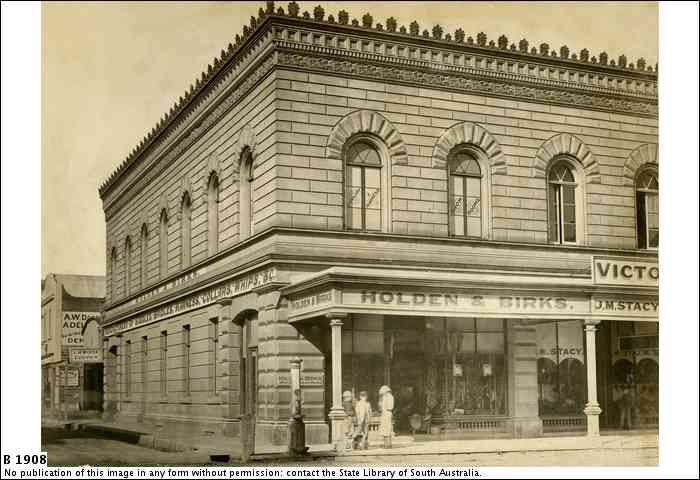 |
|
|
B 1908 - Rundle Street. South west corner of Gawler Place, 1872 |
During 1860 the Adelaide Municipal Council debated provision of drinking fountains. In March there was a proposal to install a fountain at the intersection of King William, Currie and Grenfell streets. Also that Hindmarsh, Victoria, and Light squares would be suitable localities. The motion was sent to the Waterworks committee. 'Municipal Council. Monday March 19' (SA Register, 20 March 1860).
In November 1860 the Council called tenders for: 'Providing and Fixing Drinking Fountains, of a simple and inexpensive kind, in various parts of the City' (SA Register, 1 November 1860).
The Register welcomed the fountains so long as they were not architectural monstrosities: 'but in this case economy will no doubt save us from all danger of that kind. The Corporation have so little money to spend on these undertakings that they are not likely to be spoiled by works of art; and the fountains erected will, therefore, probably be useful without being unsightly'. The number of fountains had not yet been decided as until the tenders were in and costs were known, the council would not know how many it could afford (SA Register, 1 November 1860).
By January they were nearing completion and had been viewed by a reporter from the Register. 'We have seen castings of the proposed public fountains at Mr. Wyatt's Foundry, and are glad to perceive that while they are unpretending, they are by no means inelegant. They are to stand about seven feet high, and consist each of an octagonal base relieved by sunken panels, a shaft, also eight-sided, and a simple but suitable cap. At a convenient height on the shaft a curved ornamental spout projects over a small shell-shaped basin, into which it is proposed to have a tiny stream of water continually falling from the spout, with a view of presenting to the thirsty wayfarer the pure element in the coolest possible condition. The water will on overflowing fall into a larger basin below, where dogs and other 'inferior creatures' privileged to be at large within the city may quench their thirst without let or hindrance.'
The Council had decided to install 13 of these fountains: two in Victoria Square, one in each of the other four squares, North Terrace, King William Street, Hindley and Rundle Street. There were three in North Adelaide: in Wellington square, O'Connell and Kermode Streets (SA Register, 30 January 1861).
The fountains came into operation on Tuesday 12 February 1861 'During the day numerous passers-by tested the quality of the water thus freely placed within their reach, and generally appeared to appreciate it as a welcome boon' (Adelaide Observer, 16 February 1861).
AH Gouge - who built the first reservoir- presented a drinking fountain
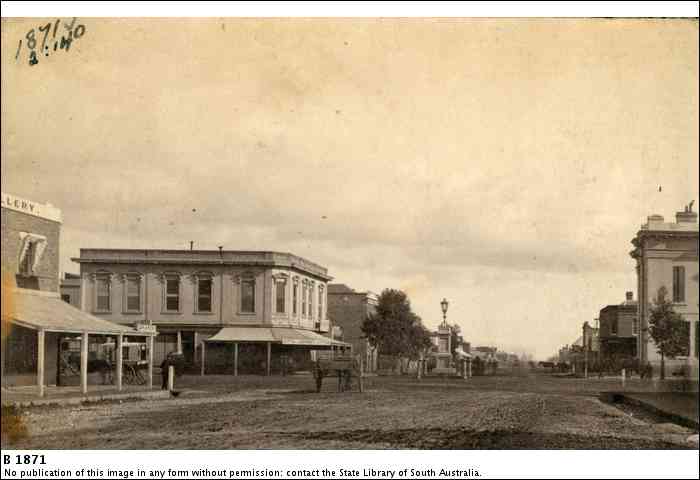 |
|
|
B 1871 - Currie Street, Adelaide, 1864 |
The first site recommended for a city council drinking fountain was the intersection of Gouger, Currie and King William Streets. AH Gouge, who had the contract for building the Thorndon Park Reservoir, presented a fountain for this site.
In March 1861 the South Australian Weekly Chronicle paid a visit to Kellett's stone-yard in Waymouth Street to view the fountain under construction. It was 15 feet high, 5 feet square at the base and made of Macclesfield marble (SA Weekly Chronicle, 30 March 1861).
In March the stone was in a rough state but by June the fountain was ready for assembly. Four sides of the column had place for plate glass panels to 'be used for the display of public notices' (Adelaide Observer, 8 June 1861).
A drinking fountain for advertising was not welcomed
We hope ... the public may be guarded against the suggestion which has been mooted for making use of the movement to extend to Adelaide the unsightly placarded pillars lately set up in London. The rage for "indicators" has there, much to the amusement of foreigners, caused all the lamp-posts to become converted into square pillars, setting forth in staring letters of all colours the advantages of Holloway's pills, Moses's vests, and Brown's baking powder. Such is the classic idea which the Corporation has been urged, we learn, to introduce here by the erection of a fountain indicator in the most conspicuous part of King William-street, but we cannot believe they will abuse the confidence of the citizens by perpetrating any such absurdity (SA Register, 4 March 1861).
Gouge wrote to set the record straight: it was tasteful, there were only four panels to be used for advertising, he had a liberal offer for using them and the proceeds would be 'handed over to the Society of Arts, to be distributed as prizes to the youth of this colony at their annual exhibitions' (SA Register, 7 March 1861).
After a few months vandals broke three of the panes. Stories varied: it might have been a large stone or heavy material. Someone was rumoured to have seen a group fire a pistol at the glass, 'but unfortunately no clue has been discovered as to their whereabouts'. Another report said the police were looking for three men on horseback said to have been the perpetrators. It was not an isolated incident. The bar window of the City Bridge Hotel and several places in North Adelaide were also damaged. Gouge offered a reward of 10 for 'conviction of the rascal or rascals'.
The Adelaide Observer hoped the damage would end the advertising (Adelaide Observer, 26 October 1861). This in fact happened: 'the panes of glass, which were previously intended for advertising purposes, have been very judiciously removed, polished marble slabs being substituted' (SA Register, 12 December 1861).
Photographs of King William street show horse-cabs parking in the middle of the road in line with the fountain. But by about 1880 the fountain was an obstruction. It was moved to Hurtle Square. When electric tram lines were installed in 1908 it was removed and the City Council adopted a suggestion to install it at the corner of West Terrace and Henley Beach Road (Adelaide Observer, 24 October 1908).
Drinking fountains could provide useful memorials
Municipal Corporations, public companies, and private individuals have of late hit upon an excellent and useful way of saving themselves from future obscurity. Brass and stone have been the memorials of kings and warriors for ages past; but lesser mortals have now discovered the means of ensuring themselves not only fame, but genuine honour, by memorials of an altogether different character. In fact, they write their names in water, but so legibly that men shall read them and bless the writers as long as there is a drop of the precious fluid left (SA Register, 1 November 1860).
Port Adelaide, Kensington and Glenelg Fountains
|
|
|
|
John Formby was prominent in Port Adelaide affairs. He was a JP and Mayor of Port Adelaide for four successive years. A committee decided a drinking fountain would be a suitable mark of appreciation, and a public subscription raised the money 'to order a handsome fountain from Scotland'. It was installed on North Parade opposite Nelson Street and unveiled on Saturday 27 May 1877 by the Mayor in the presence of Mr Formby, a crowd of citizens and a large number of visitors from Adelaide. After the opening there were more speeches over lunch at the Town.
North Parade was chosen as a site 'where a large number of men are constantly at work through the heat of the day.' There was already a fountain in Commercial Road.
The fountain proper is of iron bronzed, standing upon a square of three steps, the first from the ground of Macclesfield marble, and the other two of Mintaro slate. The fountain itself rises to the height about eight feet, and its design, besides being elegant, is somewhat novel. Four arches formed in a very tasteful manner are surmounted by an ornamental dome, beneath which is a peculiarly constructed support with four branches, from which depend the cups. The outlets for the water are so arranged as to only allow the fluid to flow when a knob beneath the spout is pressed by the cup when a person wants to fill it, so that there is no waste from constant running as in ordinary fountains. Above each arched opening is a shield, and the one facing the Parade bears the inscription - 'Erected by public subscription to John Formby, Esq., Mayor, 1870-1-2-3.' Messrs. McFarlane & Co., of Glasgow, made the fountain, and Mr. Pybus erected it. The cost was altogether about 100, and in point of usefulness no better choice or locality could be found, as there was a great want of such a convenience on the Parade (SA Register, 29 May 1876).
Ironically there are three surviving examples of this 'novel' design dating to within just a few years of each other. One at Glenelg was 'Presented to the Mayor and Corporation of Glenelg by Wm. Townsend, Esq., M.P., October, 1877.' It was originally placed in Colley Reserve, flanked by guns from the Buffalo (Glenelg illustrated, 1836-1896). At one time this Victorian ironwork had the fountain part replaced with a stone construction in a vaguely art-deco design that detracted from its appearance. It has now been moved to the Partridge House community centre.
The third, on Portrush Road, at the end of High Street, Kensington was 'Erected by public subscription in affectionate remembrance of the late John Benson, surgeon, 1877'.
Although there were local foundries that included cast iron fountains in their catalogues these three fountains were ordered from Walter Macfarlane & Co's Saracen Foundry in Glasgow. The design is number 8 in their catalogue. A specialist Scottish website has a database cast iron structures not only in the United Kingdom, but around the world. Two of the Adelaide fountains are represented.
The catalogue shows an elaborate structure above the bowl. It held the water outlets, cups on chains, and was topped by an egret. Interestingly the egret seems to have been replaced by a kangaroo. These can bee seen in some contemporary drawings and on the Henderson drinking fountain outside the North Melbourne Town Hall. Unfortunately they are missing from all the Adelaide examples.
Controversy over the Kensington Fountain
The Benson Memorial Fountain is on a triangle of land 'granted by the Convent of St Joseph whose inmates benefited from Benson's regard'. Less than ten years later, the local council decided to move the fountain to the edge of the triangle and install a weighbridge. The Benson trustees objected. On legal advice council decided to abandon the idea, but there was some heated debate on the issue and the trustees ensured they received a deed of trust that gave them the ownership (Express, 13 September 1898).
Several other cast iron memorial fountains
|
B 45673/3 - Adelaide Botanic Gardens: Moreton Bay fig and drinking fountain |
The drinking fountain in Hutt Street, Adelaide has a plaque to say it was presented to the Glenelg Corporation by Councillor M McCallum on 19 July 1911 but there's nothing to say what its doing in the CBD. It looks as if a lamp or some other decoration is missing from the top, but otherwise is in excellent condition.
The fountain near the summer house in the Botanic Gardens was the gift of TR Scarfe, JP, in 1909. It has no maker's plate but the Scottish Ironworks website points out the similarity to a fountain at Kay Park, Kilmarnock, and gives the manufacturer as McDowall, Steven & Co Ltd and the foundry as Milton Ironworks Glasgow.
The rather top heavy drinking fountain near the Town Hall on Unley Road was erected in 1909 as a memorial to John Miller, Unley's Town Clerk from 1879 to 1903 who implemented many improvements to the area particularly in roads, drainage and lighting. Unlike the other memorial fountains this was a local product, cast by the J Martin foundry at Thebarton.
Adelaide foundries
|
B 26367 - Fountain, Port Augusta, 1890 |
The State Library has catalogues of a number of Adelaide foundries. Stewart & Harley, later AC Harley & Co. ran the 'Sun' Foundry in Hindley Street. Their drinking fountains range from smaller models to an elaborate fountain and canopy.
Photographs of the Beaton Memorial Fountain in Commercial Road, Port Augusta look very similar to an illustration in the Harley catalogue. According to the Port Augusta Sketchbook, 1977 the fountain commemorates James Beaton, the Port Augusta postmaster for 24 years.
The fountain was moved from Commercial Road to Gladstone Square. Information as to the manufacturer would be welcomed.
Stone drinking fountains
Perhaps the best known is the Gardner Memorial Fountain in Elder Park. We talked about Adelaide fires in October 2005. Gardner was one of two firemen killed by a Rundle Street fire on Christmas eve, 1886. Several members of the South Wanderers Cricket Club knew Gardner and organised a committee that raised enough money to fund a tombstone, drinking fountain and life-size portrait.
'The fountain, which with the fixtures has cost about 100, is of chaste Gothic design, and is situated within the Rotunda enclosure in close proximity to the footpath. It is of white Kapunda marble, and stands 9 ft. 8 in. high, and is about 4 ft. square. The bases are of West Island Granite, and over the stand, on which are the four taps and basin, is a canopy supported on four columns of Kapunda Blue marble. The canopy, which was hewn out of one block of white marble weighing 3 tons, is ornamented underneath, and on each side there is a representation of an olive wreath, enclosing a shield bearing the inscription. "Fireman Gardner's Memorial, 1887." The whole of the work was designed and executed by Mr. F. Herring, of West-terrace. Mr. Harrison provided the necessary pipes and connection with the water-main at his own expense.'
Whyte Memorial, Brighton
The Australian and Balmoral granite drinking fountain near the Brighton Jetty commemorates Mrs Kitty White who was taken by a shark on 18 March 1926.
She taught swimming at Brighton for many years. She saved a swimmer from drowning in 1919 for which she was awarded a Grand Diploma by the Royal Lifesaving Society. Mrs. Whyte had also promoted the welfare of the district and had been an ardent war worker.
The fountain, made by John Tillett of Adelaide, was erected by the Women of Brighton in her memory. These days the water outlets have been filled in with matching marble inserts, and the fountain serves no useful purpose.
Belt Memorial Fountain, Walkerville
William Charles Belt, chairman of the Walkerville Council in 1859 and 1863 was a barrister who came to Adelaide in 1851. His residence was The Almonds, Walkerville.
His daughter donated the Belt Fountain in 1924 - a stone summer house with seats and a stone fountain in the centre. Water drains to a small basin on the outside edge of one side of the octagonal base.
As with the Brighton fountain the structure has been retained but the fountain is no longer in service.
Standard drinking fountains show variety
Street fountains - or more frequently these days - fountains in parks, playgrounds and reserves, tend to be more utilitarian, even if each shows the design features of its time. The main difficulty is that being outdoors the drain holes are likely to clog allowing the bowls to fill up. Rusting is a feature of many cast iron examples. Stainless steel and powder-coating finishes are more resilient than older materials. The elegant curved model photographed on North Terace has waste water run down the curve of the pedestal to a drain at pavement level and seems to be a particularly efficient model.
More Afternoon Delights
ABC Afternoon Delights at the State Library was a series in which Carole Whitelock talked with Michael Talbot from the State Library about South Australian topics, illustrated by items from the Library's collections. View the associated SA Memory page for each topic.


